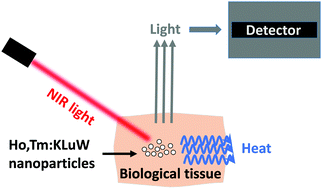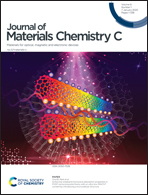Short-wavelength infrared self-assessed photothermal agents based on Ho,Tm:KLu(WO4)2 nanocrystals operating in the third biological window (1.45–1.96 μm wavelength range)†
Abstract
KLu1−x−yHoxTmy(WO4)2 nanocrystals with different atomic concentrations (x = 0.01, 0.03, 0.05, 0.075, 0.1, 0.15 and y = 0.05, 0.1, 0.2) were synthesized via the modified sol–gel Pechini method, using ethylenediaminetetraacetic acid as the chelating agent, and polyethyleneglycol as the esterification agent. Different doping levels were implemented with the goal to determine the optimal ratio for maximizing the intensity of their optical emission in the short-wavelength infrared (SWIR) region, their thermal sensitivity as luminescent thermometers and the photothermal conversion efficiency to act as photothermal agents. The obtained KLu1−x−yHoxTmy(WO4)2 nanocrystals exhibit a monoclinic structure and an irregular shape, with a size of around 150 nm. The photoluminescence spectrum in the SWIR region of the obtained nanocrystals, excited at 808 nm, shows three main bands attributed to the electronic transitions: 3H4 → 3F4 (1.45 μm) and 3F4 → 3H6 (1.8 μm) of Tm3+ and 5I7 → 5I8 (1.96 μm) of Ho3+. The temperature dependency of the three emission bands was recorded in the physiological range of temperatures from 293 K to 333 K, displaying a relative thermal sensitivity (Srel) of 0.90% K−1 at 293 K for the doping level of 1 at% Ho3+ and 10 at% Tm3+, representing the highest reported up to now in the SWIR region. The photothermal conversion efficiency (η) of the KLu1−x−yHoxTmy(WO4)2 nanocrystals is 40 ± 2% for the same doping levels, being competitive with other photothermal agents reported before, like metallic and semiconductor nanocrystals. The simultaneous ability of these nanocrystals to combine photothermal conversion efficiency and thermal sensing in the SWIR is demonstrated through an ex vivo experiment.



 Please wait while we load your content...
Please wait while we load your content...